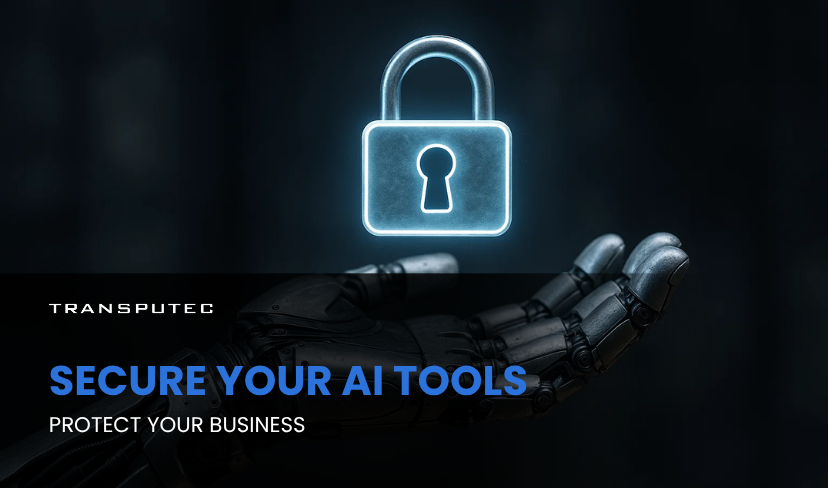Written by KRITIKA SINHA | MARKETING
Imagine this: your customer service chatbot gets hijacked. It starts leaking sensitive client data. The AI-based fraud detection system you’ve invested in suddenly starts behaving unpredictably. Worse still, your AI is compromised without you even noticing, making decisions that hurt your company. Sounds extreme? It’s not.
A 2023 study by IBM found that data breaches involving AI systems cost companies $4.45 million on average, with over 38% of AI-driven businesses reporting at least one major security incident in the last 12 months. While AI brings remarkable efficiencies, it also creates attack surfaces that cybercriminals are racing to exploit.
This blog unpacks the real threats, solutions, and smart strategies to Secure Your AI Tools before they become liabilities. From understanding vulnerabilities to deploying bulletproof security protocols, we’ll help you build AI resilience, backed by actionable insights and expert advice.
What Makes AI Tools So Vulnerable to Cyberattacks?
Despite their intelligence, AI systems are far from invincible. Most operate on massive volumes of data and require integration with multiple applications—both of which increase their risk profile. Here are the most common vulnerabilities:
- Data Poisoning: Attackers feed corrupt data into your AI system during training, skewing results or triggering malicious actions.
- Model Theft: Hackers clone your proprietary models, stealing intellectual property or reproducing them for malicious use.
- Adversarial Attacks: By making subtle changes to inputs, bad actors can trick your AI into making wrong decisions (e.g., facial recognition bypasses).
- APIs as Entry Points: Public or weakly secured APIs often act as backdoors into your AI infrastructure.
These aren’t theoretical risks. In 2022, Microsoft’s AI-based chatbot Tay was manipulated into posting offensive content just 16 hours after launch, demonstrating how quickly AI systems can go rogue.
Secure Your AI Tools by Understanding the Lifecycle Risks
1. Data Collection: The Foundation of AI Vulnerability
Risk: Ingesting compromised or biased data
Explanation: AI models are only as good as the data they learn from. If your input data is inaccurate, unverified, or maliciously altered (a tactic known as data poisoning), the model will produce unreliable or dangerous outcomes. For example, feeding manipulated transaction data into a fraud detection model can teach it to ignore real threats.
Solution:
- Use secure data pipelines with encryption in transit and at rest.
- Implement automated validation checks to detect anomalies.
- Rely on reputable data sources and avoid open datasets unless verified.
2. Data Preparation & Labelling: A Hidden Backdoor for Attackers
Risk: Human error or malicious labelling
Explanation: Data labelling is often outsourced or done manually, which opens the door to subtle manipulation. Attackers can mislabel images or text to bias model training, or insiders could sabotage the process to embed vulnerabilities into the model.
Solution:
- Audit labelling processes regularly.
- Use AI-driven tools to double-check labels for accuracy.
- Limit access to labelling environments with strict identity and role management.
3. Model Training: Where Compromise Can Go Unnoticed
Risk: Unauthorised modifications and adversarial attacks
Explanation: During training, models are vulnerable to adversarial examples, carefully crafted inputs that look normal to humans but trick AI into making incorrect decisions. Also, if hackers gain access to your training environment, they could insert code or manipulate weights.
Solution:
- Train models in isolated, monitored environments.
- Employ version control and track changes rigorously.
- Introduce adversarial robustness testing to harden models against manipulation.
4. Model Deployment: When Exposure Increases Significantly
Risk: API misuse and lack of runtime protection
Explanation: Once your model is deployed, especially via APIs, it becomes accessible to users and potentially to attackers. Without proper rate limits, encryption, and input validation, these APIs can be used to extract model logic, cause outages, or launch inference attacks.
Solution:
- Secure your APIs with token-based access and usage limits.
- Monitor access logs in real time.
- Use API gateways with built-in anomaly detection to block suspicious behaviour.
5. Monitoring & Maintenance: Ignoring This Stage is a Common Mistake
Risk: Model drift, performance degradation, and undetected misuse
Explanation: After deployment, models can degrade over time due to changes in data patterns (model drift). Without regular monitoring, your AI might start making flawed decisions, and malicious actors could exploit performance blind spots unnoticed.
Solution:
- Implement continuous monitoring with automated alerts for anomalies.
- Compare new outputs against expected outcomes to detect drift.
- Regularly retrain models with updated, validated data.
Ready to Explore AI for Your Business?
Connect with our new AI division, Kuhnic, today for the free consultation!
Secure Your AI Tools with These 7 Best Practices
1. Use Zero Trust Architecture
Never automatically trust anyone inside or outside your network. Always check first. Hackers can pretend to be employees or users. If your system trusts them too easily, they can break in.
How to Do It:
- Ask for multiple proofs of identity (like a password and a text code).
- Limit access to AI systems based on job role.
- Keep track of who accesses what and when.
2. Encrypt and Protect Your Data
Hide your data using encryption so that even if someone steals it, they can’t read it. AI uses a lot of sensitive data. If that data is stolen, your business and customer trust are at risk.
How to Do It:
- Always encrypt data when storing it and when sending it across the internet.
- Use tools that turn personal data into meaningless tokens (called tokenisation) to make it even safer.
3. Test Your Security with Ethical Hackers
Let trained professionals try to hack your AI tools safely. This helps you find weak spots before real hackers do.
How to Do It:
- Hire a cybersecurity expert or team to do penetration testing.
- Review the results and fix any issues they find.
- Repeat the test regularly—at least once or twice a year.
4. Lock Down Your APIs
Protect the connections (APIs) your AI tools use to talk to other apps. APIs can be a weak point where hackers sneak in.
How to Do It:
- Use secure keys or tokens for every API call.
- Limit how many times someone can use an API in a short time.
- Block any strange or sudden traffic patterns.
5. Limit Who Has Access to What
Not everyone in your company should have access to every part of your AI systems. If one employee account is hacked, the damage will be smaller if that person only had access to a small part.
How to Do It:
- Use role-based access control (RBAC).
- Regularly check and update who has access.
- Remove access immediately when someone leaves the company.
6. Understand and Explain What Your AI Is Doing
Use tools that help you see how your AI makes decisions. If your AI starts making bad or biased decisions, you need to know why.
How to Do It:
- Use tools like SHAP or LIME that show how your AI thinks.
- Share these explanations with your team or auditors.
- If you see strange decisions, investigate quickly.
7. Keep Your AI Tools Updated
Always install the latest software updates and security patches. Hackers often use old software weaknesses to break in.
How to Do It:
- Set up automatic updates if possible.
- Regularly check for updates for all AI software, plugins, and apps.
- Keep a list of all tools and versions you use, this helps when managing updates.
Secure Your AI Tools with Compliance and Governance
Even the most advanced security tools mean little without clear policies and compliance. Here’s how governance helps you Secure Your AI Tools:
- GDPR, HIPAA, and ISO 27001 should form the baseline of your compliance strategy.
- Maintain audit trails for every decision made by your AI systems.
- Set up a governance board that includes IT, legal, compliance, and business unit leaders.
- Use Model Risk Management (MRM) frameworks like those from the Federal Reserve to classify and manage AI models based on their risk exposure.
A Gartner report found that by 2026, 60% of enterprises will require governance for all AI systems as part of their security protocol.
Real-World Threats that Prove You Must Secure Your AI Tools
Consider these incidents:
- Tesla’s AI-based autopilot was tricked by simple road markings, leading to system malfunctions.
- Google’s AI algorithm flagged innocent content as extremist due to biased training data.
- Healthcare AI platforms in the UK misdiagnose patients because of unverified data inputs, exposing medical institutions to liability.
What ties these examples together? Lack of a robust AI security strategy. You can’t afford to be next.
Secure Your AI Tools with Transputec’s AI Security Expertise
Transputec understands the delicate balance between AI innovation and security. Our team has been helping enterprises build secure infrastructures for over 35 years. Whether you’re deploying chatbots, predictive analytics, or machine learning models, we provide a full suite of services to help you Secure Your AI Tools:
- AI Security Audits
- Cloud & On-Premise AI Protection
- AI Governance and Compliance Services
- Incident Response and Recovery Plans
- Custom AI Threat Modelling
Conclusion
AI isn’t just a competitive advantage anymore; it’s a potential security liability if not properly managed. We’ve covered the real-world threats, the lifecycle risks, best practices, compliance strategies, and tools you need to protect your AI infrastructure.
Don’t wait until your AI tools become your weakest link. Proactive steps today can save you from millions in damages, loss of trust, and operational chaos tomorrow.
Contact us to connect with an expert and get started with Transputec. Let’s help you Secure Your AI Tools before it’s too late.

Don’t Let Hackers Win—Act Now!
Connect with an expert and get started on the next generation of IT support.
FAQs
1. Why is it critical to Secure Your AI Tools now more than ever?
AI is now embedded in business-critical functions. Hackers exploit AI’s dependencies on data, APIs, and machine learning models to launch sophisticated attacks. As these threats become more targeted, companies must act quickly to avoid disruption, data loss, and brand damage.
2. How does Transputec help Secure Your AI Tools?
Transputec offers comprehensive AI security services, including vulnerability assessments, API hardening, AI-specific penetration testing, and regulatory compliance support. With over 35 years in IT security, Transputec delivers tailored protection for enterprise-grade AI.
3. Can small and mid-sized businesses afford to secure AI Tools effectively?
Yes. Transputec provides scalable, cost-effective AI protection plans. From cloud-based tools to hybrid models, we design solutions that fit your budget without compromising on security.
4. What industries benefit the most from securing AI tools?
All industries using AI finance, healthcare, manufacturing, logistics, and retail, can benefit. Sectors handling personal data or regulated information are especially vulnerable and require urgent attention.
5. How often should companies audit their AI systems for security?
At least quarterly. Transputec recommends monthly security reviews for high-risk AI systems and real-time monitoring where feasible. We help set up automated tools to detect threats proactively.






